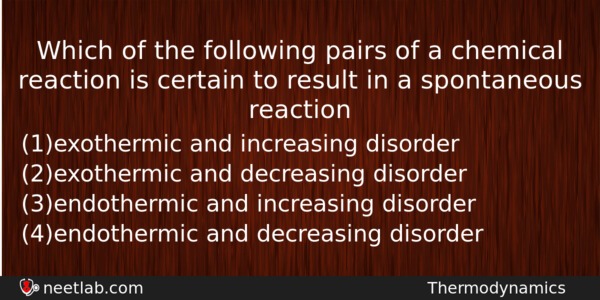| ⇦ | 
| ⇨ |
Which of the following pairs of a chemical reaction is certain to result in a spontaneous reaction
Options
(a) exothermic and increasing disorder
(b) exothermic and decreasing disorder
(c) endothermic and increasing disorder
(d) endothermic and decreasing disorder
Correct Answer:
exothermic and increasing disorder
Explanation:
For spontaneous reaction ΔH = -ve, ΔS = +ve. Spontaneity depends upon both critical minimum energy and maximum randomness / disorder.
Related Questions: - Among the following the paramagnetic one is
- Which of the following is low boiling liquid
- When a mixture of calcium acetate and calcium formate is dry distilled, the
- Last molecule of H₂O is evolved from H₂O₂ by
- In Lassaigne’s test red colour precipitate is obtained which is due to formation
Topics: Thermodynamics
(179)
Subject: Chemistry
(2512)
Important MCQs Based on Medical Entrance Examinations To Improve Your NEET Score
- Among the following the paramagnetic one is
- Which of the following is low boiling liquid
- When a mixture of calcium acetate and calcium formate is dry distilled, the
- Last molecule of H₂O is evolved from H₂O₂ by
- In Lassaigne’s test red colour precipitate is obtained which is due to formation
Topics: Thermodynamics (179)
Subject: Chemistry (2512)
Important MCQs Based on Medical Entrance Examinations To Improve Your NEET Score
18000+ students are using NEETLab to improve their score. What about you?
Solve Previous Year MCQs, Mock Tests, Topicwise Practice Tests, Identify Weak Topics, Formula Flash cards and much more is available in NEETLab Android App to improve your NEET score.
Share this page with your friends

Leave a Reply